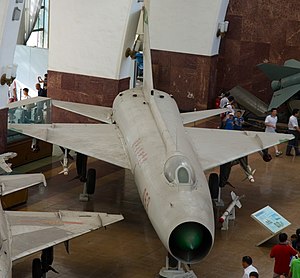Shenyang J-8
| J-8 / F-8 | |
|---|---|
 |
|
| The original J-8 fuselage design at the Beijing Military Museum | |
| Role | Interceptor |
| National origin | China |
| Manufacturer | Shenyang Aircraft Corporation |
| Designer | Shenyang Aircraft Design Institute |
| First flight | J-8: 5 July 1969 J-8II: 12 June 1984 |
| Introduction | 1980 |
| Status | In service |
| Primary users |
PLA Air Force PLA Naval Air Force |
| Produced | 1979 – present |
| Number built | 380 |
The Shenyang J-8 (: 歼-8; NATO reporting name: Finback) is a high-speed, high-altitude Chinese-built single-seat interceptor fighter aircraft.
The effort to develop an all-weather interceptor began in full in 1964 and this produced the first Chinese-designed and built jet fighter to combat new, high altitude threats such as the B-58 Hustler bomber, F-105 Thunderchief fighter-bomber and Lockheed U-2 spy plane. In 1964 the People's Liberation Army Air Force requested an aircraft from Shenyang Aircraft Corporation and the 601 Institute to develop a fighter/interceptor to counter bombers and spy planes as the, then, newly introduced Chengdu J-7 (a reverse engineered MiG-21) was incapable of doing so. The prototype took its maiden flight in 1969. Despite the early-mid to late 1960s origins of the J-8, due to the political turmoil of the Great Proletarian Cultural Revolution, the J-8 was not produced until 1979 and entered service in 1980. Its basic configuration resembles an enlargement of the delta-winged J-7, utilizes two Liyang (LMC) Wopen-7A turbojet engines, and features a maximum speed of Mach 2.2. The twin engined J-8 competed with rival Chengdu Aircraft Industry Group's single, turbofan powered engine, canard-delta J-9 project and ultimately emerged as the victor largely due to the existing availability of the former's MiG-21 based powerplant and proven layout, while the J-9 project was cancelled in 1980 due to difficulty in creating a suitably powerful engine.
In order to house a large radar set, the design called for a solid nose and variable geometry side air intakes. However, the lack of familiarity with this type of intake meant the J-8 had to settle for a MiG-21 style nose intake. The solid nose J-8 was finally realized in the J-8II (Finback-B), which was based on the layout of the J-8I (same improvement is like the J-6 to Q-5). The radar chosen for the J-8 was the Type 204 mono-pulse fire-control radar, a primitive ranging radar for daylight within-visual-range operations. The performance of the radar fell well short of the PLAAF's requirements as research into a more capable fire control radar and power source proved difficult and time-consuming. The aircraft was originally armed with cannons and seven hardpoints for missiles, bombs, rockets or fuel tanks. The original weapons layout of the J-8 was two 30 mm Type 30-1 cannons after initial problems with the 30 mm Type 30-II four-barrel Gatling gun. The J-8 was also planned to be armed with the experimental PL-4 medium ranged missile but technical issues and political upheavals prevented any in-depth development and the project was cancelled in 1985 citing unsatisfactory performance. Therefore, the PL-2 IR-homing short-range air-to-air missile (SRAAM) was used instead. Unguided bombs and rockets can also be carried on the J-8. And nowadays with the development of light-weight military nuclear weaponry, the J-8II will now be able to carry missiles with nuclear warheads.
...
Wikipedia
